Help desk software enable companies to keep track of user requests and handle other customer service-related issues. Based on the market presence, features, and pricing, I selected the top 10 software. See my rationale by clicking the links:
- Freshdesk
- Zendesk Support Suite for mid-market companies and businesses seek pay-as-you-go plans
- Zoho Desk
- Salesforce Service Cloud for enterprises with Salesforce CRM products
- Intercom
- LiveAgent
- LiveChat
- Front
- HubSpot Service Hub for businesses already using or planning to use HubSpot’s suite of tools
- Jira Service Management
Data security features
| Vendor | SOC | ISO 27001 | HIPAA |
|---|---|---|---|
| Freshdesk | SOC 1 SOC 2 | ✅ | ✅ |
Zendesk Support Suite | SOC 2 | ✅ | ✅ |
| Zoho Desk | SOC 1 SOC 2 | ✅ | ✅ |
| Salesforce Service Cloud | SOC 1 SOC 2 SOC 3 | ✅ | ✅ |
| Intercom | SOC 2 | ✅ | ✅ |
| LiveAgent | SOC 2 | ✅ | ❌* |
| LiveChat | No public information is available. | No public information is available. | ✅ |
| Front | SOC 2 | ❌ | ✅ |
| HubSpot Service Hub | SOC 2 SOC 3 | ✅ | ✅ |
| Jira Service Management | SOC 2 SOC 3 | ✅ | ✅ |
See feature desriptions.
*LiveAgent is not HIPAA compliant. However, it can be customized to comply with HIPAA regulations by implementing appropriate security measures for patient data. This includes installing SSL certificates for encryption-based Internet security, and enforcing 2FA for agents.
Other features & integrations
| Vendor | Live chat | Feedback surveys | Integrations | Supported languages |
|---|---|---|---|---|
| Freshdesk | ✅ | Large-scale plans | 650+ | 30+ |
Zendesk Support Suite | ✅ | Large-scale plans | 1,200+ | 30+ |
| Zoho Desk | Enterprise plans | ✅ | 5,000+ | 40+ |
| Salesforce Service Cloud | ✅ | Large-scale plans | 2,500+ | |
| Intercom | ✅ | Add-on | 350+ | 44+ |
| LiveAgent | ✅ | Large-scale plans | 200+ | 43+ |
| LiveChat | ✅ | ✅ | 6,000+ | 45+ |
| Front | ✅ | Large-scale plans | 1,000+ | N/A |
| HubSpot Service Hub | ✅ | ✅ | 1,400+ | 14 |
| Jira Service Management | Add-on | Add-on | 1,000+ | 21 |
Market presence
| Vendor | Total reviews | Average rating | Free trial | Pricing (seat/month) |
|---|---|---|---|---|
| Freshdesk | 6,600 | 4.4/5 | 14-day | $15.00 |
Zendesk Support Suite | 10,355 | 4.3/5 | 14-day | $55.00 |
| Zoho Desk | 7,201 | 4.4/5 | 15-day | $7.00 |
| Salesforce Service Cloud | 4,593 | 4.4/5 | 30-day | $25.00 |
| Intercom | 4,372 | 4.5/5 | 14-day | $29 |
| LiveAgent | 3,131 | 4.6/5 | 7-day | $9.00 |
| LiveChat | 2,483 | 4.6/5 | 14-day | $20.00 |
| Front | 2,257 | 4.5/5 | 7-day | $15.00 |
| HubSpot Service Hub | 2,214 | 4.3/5 | ✅ | $18.00 |
| Jira Service Management | 1,971 | 4.2/5 | 30-day | $21.00 |
See vendor selection criteria.
Here is our research about help desks:
- Help desk benchmarking
- Help desk pricing
- The most common help desk tickets
- Open-source help desks.
Help desk benchmarking: Compare 3 products
| Vendor | UX | Agent reporting options | Time tracking sheet | Ticket filtering by sentiment | CSV export |
|---|---|---|---|---|---|
| Freshdesk | Easy | Time spent on work Time spent away from work Time spent logged in | ✅ | ✅ | ❌ |
| Zendesk Support Suite | Easy | Time spent on work | ❌ | ❌ | ✅ |
| LiveAgent | Moderate | Time spent on work | ✅ | ❌ | ✅ |
See benchmark methodology.
Description of table capabilities:
- UX: How easy is it to use the ticketing interface.
- Agent reporting options include reporting capabilities regarding agent activities.
- Time tracking sheet allows users to to keep track of time spent on each task or ticket in a single dashboard.
- Ticket filtering by sentiment implements sentiment-based filtering (e.g. positive, neutral, negative) in a ticketing system.
- CSV export allows you to transfer data output in CSV.
1. Freshdesk
1.1. UX
Pros
User interface: The main menu is located in the left panel and allows you to access the most significant tools in Freshdesk. The user interface is usually easy to find thanks to obvious buttons with descriptions.
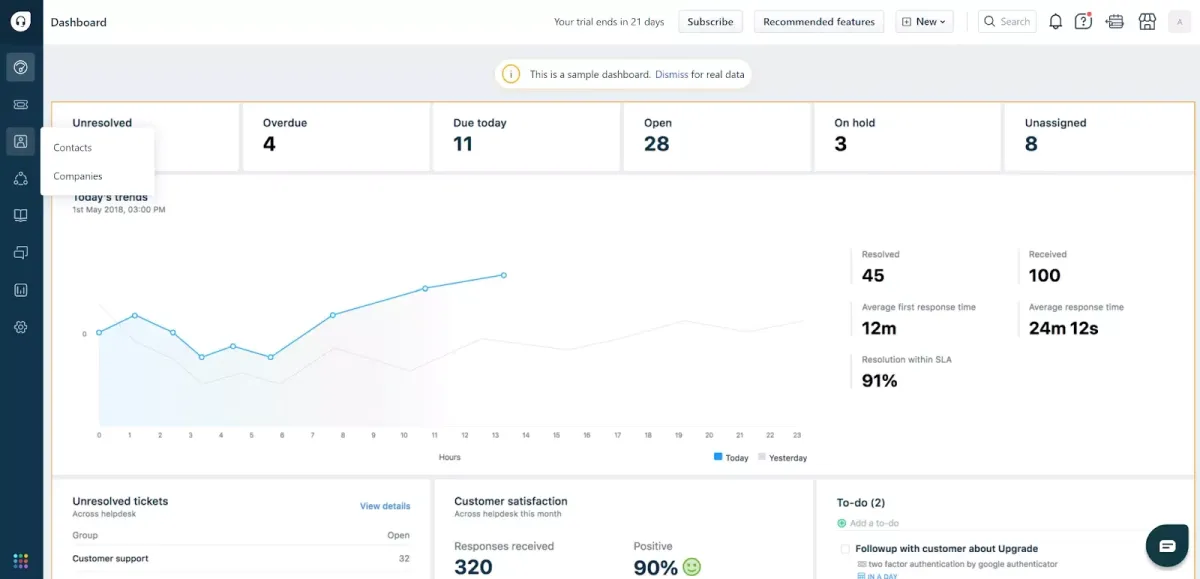
Ticket management: It is simple to add tickets. Agents can categorize tickets based on departments, resolution time, urgency, and sentiment. Other capabilities, such as “Add Note” and “Merge”, are useful for effective collaboration.
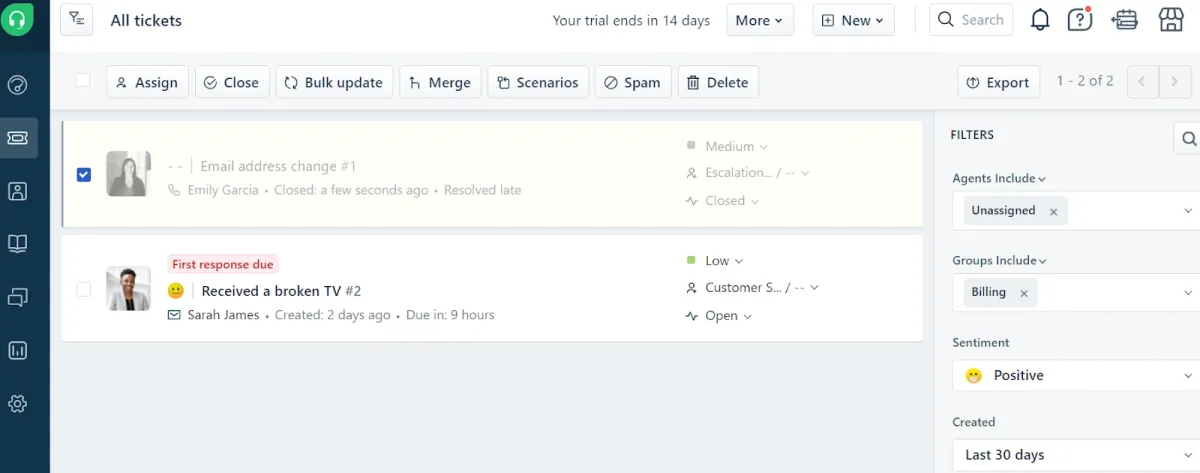
Tagging: The tag feature works effectively. Users can enter the tag’s name. They can also specify ticket types from several alternatives such as questions, incidents, problems, refunds, or feature requests. Additional choices include ticket groups, status, and priority.
Cons
Ticketing features: Freshdesk’s ticketing system lacks built-in features like “Set Ticket Field Options” to customize ticket fields based on ticket details such as date, ID, etc.
1.2. Agent reporting options
Pros
Reporting and customization: Freshdesk analytics offer detailed reporting customizations, enabling users to dive deep into trends and identify areas for improvement. Users can detail agent availability based on time spent on work, time spent away from work, and time spent logged in.

Cons
File export options: CSV export option for agent performance reports is not available. Users can export reports only in PDF files., making it inconvenient to conduct data analysis.

1.3. Time tracking sheet
Freshdesk offers built-in timesheet reporting to keep track of time spent on each task or ticket.

2. Zendesk Support Suite
2.1. UX
Pros
Ticket management: Zendesk Support Suite offers a highly customizable and detailed UI for ticket management. Agents can classify tickets based on tags, type, or priority.
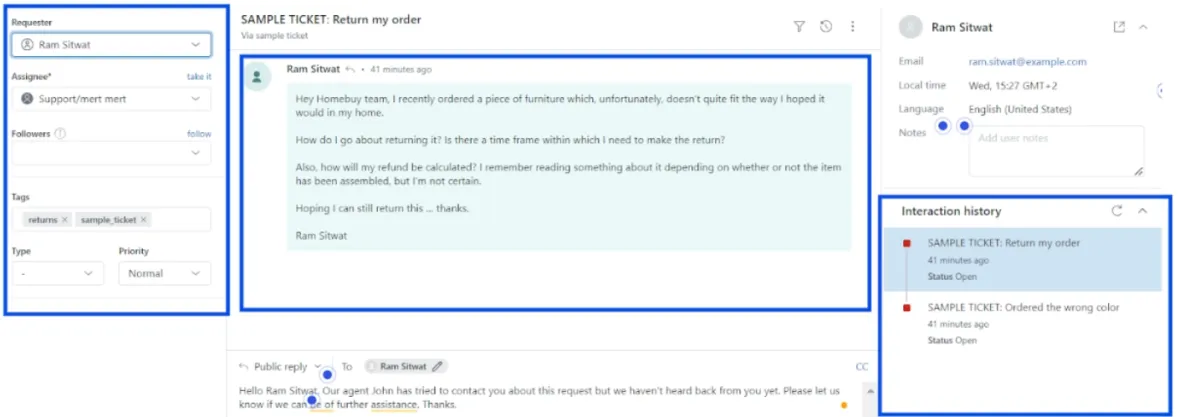
Interaction history: Zendesk Support Suite delivers ticket interaction history. Agents can display all interactions related to a ticket in chronological order, including customer responses and status changes.

AI-suggested macros: Based on the content of the ticket, built-in AI will recommend the top 3 macros to solve the ticket. Our team applied the “customer not responding” macro and Zendesk Support Suite suggested a tailored reply.

Internal notes: Users can facilitate clear communication by allowing internal notes (visible only to agents) and public comments (visible to customers).
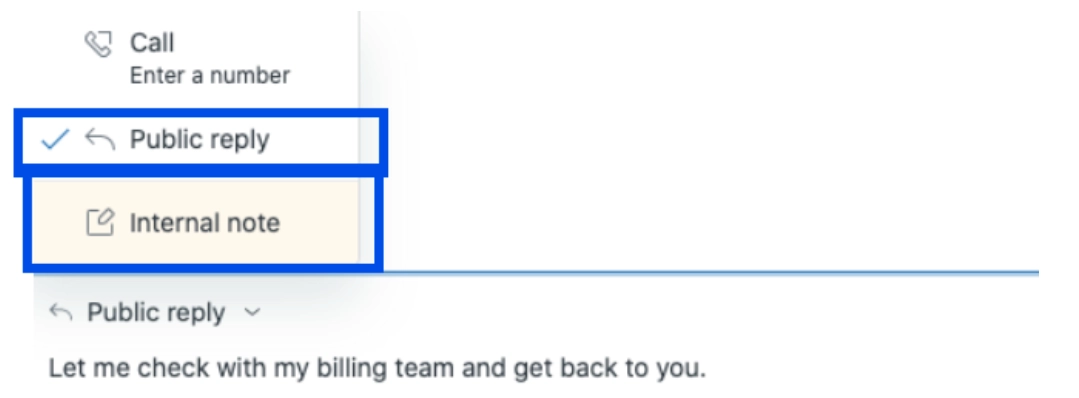
Light agents: Users can allow team members limited access to tickets without paying for additional seats. They can read tickets and provide feedback by leaving private comments.
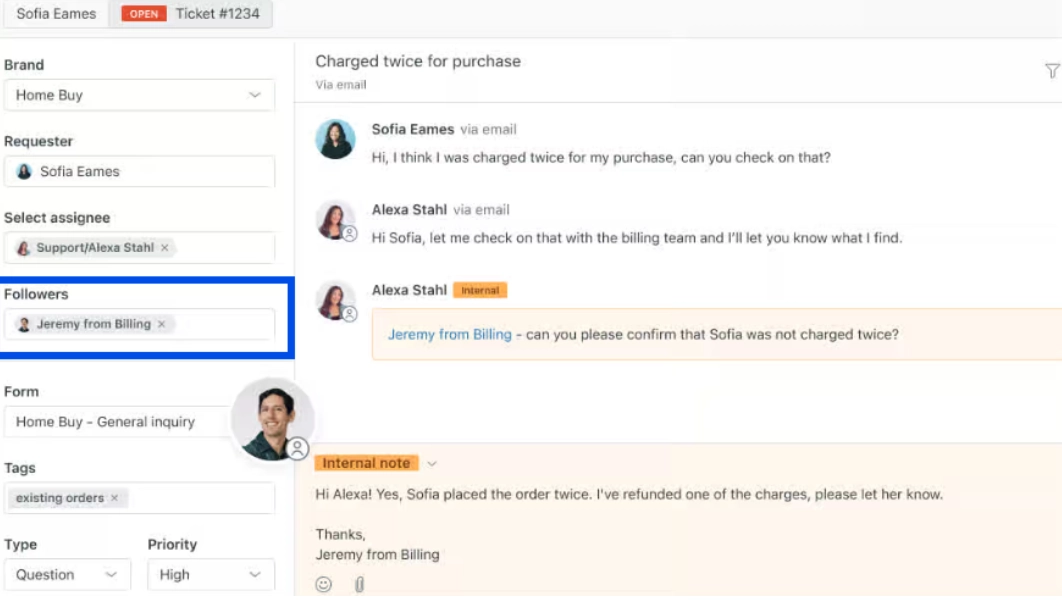
Cons
Complex ticket management: Zendesk Support Suite’s extensive features seem challenging to navigate. For example, leveraging real-time ticket reports requires significant technical knowledge and third-party integrations.
Ticket customization: Personalization and customization are available, but only for enterprise-level plans. For example, “multiple ticket forms” are only available in the high-end plans.
2.2. Agent reporting options
Pros
Dashboards: Agent performance dashboards show important analytics and insights into customer support operations based on agent types, tags, IDs, roles or names, etc. Users may also export Zendesk Support Suite data to a central database for manipulation and analysis.
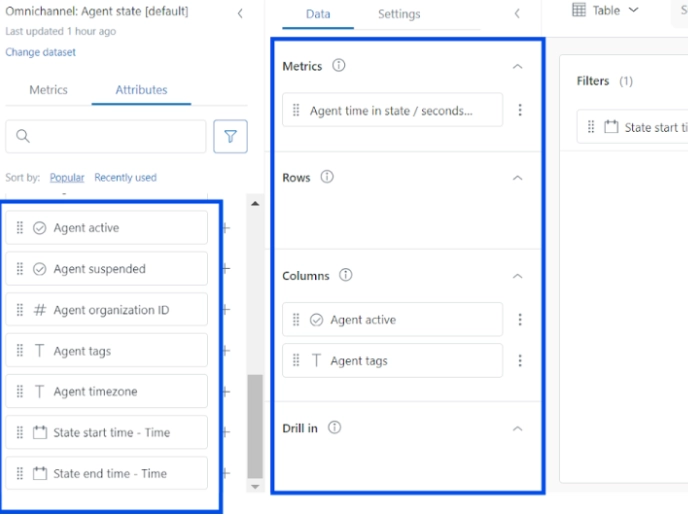
Cons
Dynamic filters: It is not possible to create a dynamic filter that changes based on the user viewing the report. The ideal approach is to develop a report/dashboard with a data filter that allows the user to choose values. However, this results in all users seeing the same default state while viewing the same dashboard.
2.3. Time tracking sheet
Zendesk Support Suite does not provide a built-in time tracking sheet. However, users can use market extensions to integrate time tracking sheets.
3. LiveAgent
3.1. UX
Pros
Ticketing customization: The ticketing system provides sufficient administration features and buttons. Users can select and sort tickets based on the following:
- status (resolved or pending etc.),
- user & ticket type,
- and importance.
CSV export: Users can export their ticketing files in CSV format. Moreover, users can select the specific columns to export, enabling a more tailored data analysis.

Cons
Filtering options: The ticket filtering options are not intuitive. Users cannot display filtering options and the tickets on the same screen, making it difficult to decide which filters to select. Yet the interface looks intertwined.
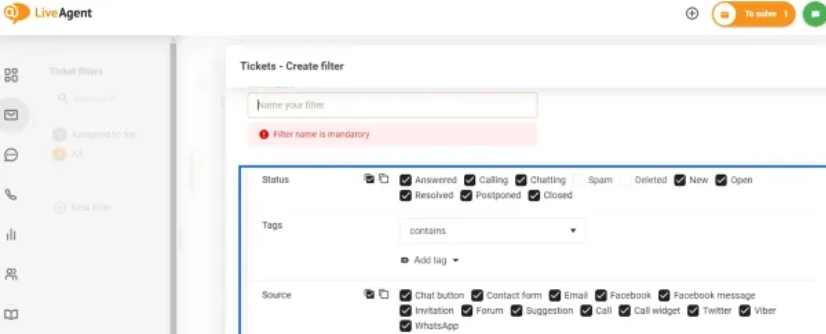
Buttons: The ticket management features such as “assign to me” or ”merge” buttons are unclear. Users have to scroll through the buttons to display their functions.
Ticket classification: Users cannot classify tickets based on business groups such as customer support, IT support, etc. All tickets are

3.2. Agent reporting options
Pros
Agent performance management customization: LiveAgent provides similar agent performance management customization options with other Freshdesk. Users can visualize agent performance in several graphical charts by leveraging filters for agent work time, finished chats, answers created tickets, etc.
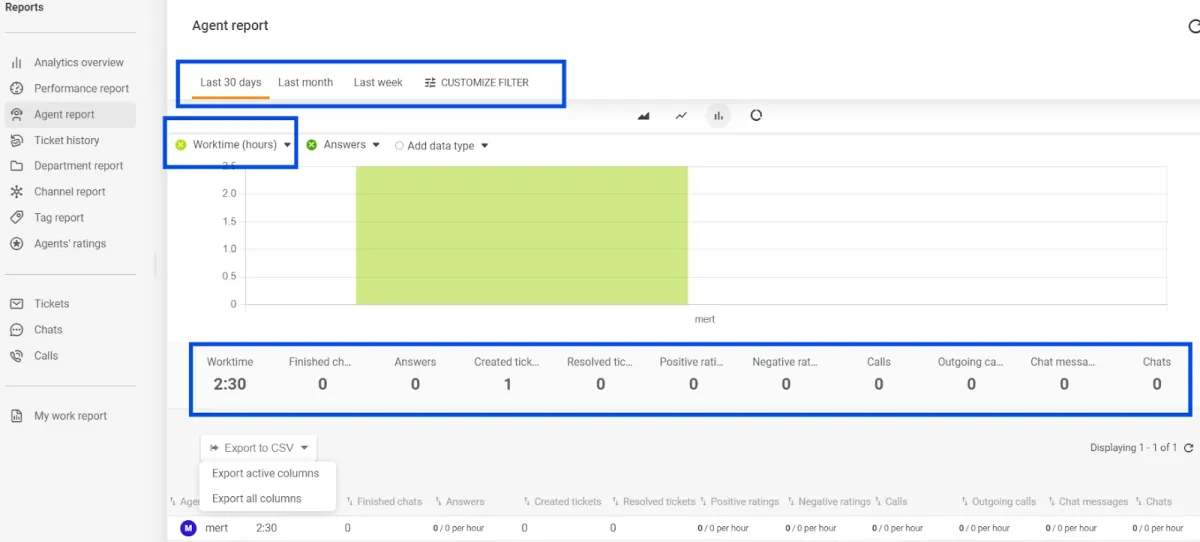
Cons
Detail reporting: Users can see agent work time, however, they cannot see time spent away from work and time spent logged in. This makes it difficult to differentiate agents who spent time at work but didn’t log in.
3.3. Time tracking sheet
The built-in time tracking function in LiveAgent allows you to monitor ticket resolution time and acquire insights into process optimization. Additionally, users can integrate TimeCamp for more detailed employee monitoring capabilities
When the time tracking feature is enabled, it tracks how much time each agent spends handling certain tickets. Time tracking counts agent working time only if a ticket is:
- opened by an agency,
- viewed by an agent,
- worked on by an agent (the agent must be writing, clicking, or moving their mouse).

Top 10 help desk software evaluation
80% of executives believe their customer experience is “superior”, however, customers think that only 8% of organizations are providing a superior customer experience.1
AI help desk software helps organizations streamline agent processes and eliminates redundant tasks with automatically generated case summaries. This enables companies to scale their support at no additional cost while improving the employee experience.
Disclaimer: Insights (below) come from our experience with these solutions as well as other users’ experiences shared in Capterra 2 , and G23 .
Freshdesk
Freshdesk is a SaaS-based online help desk software from Freshworks.
The platform transforms requests from phone, e-mail, chat, and social media channels into tickets by using its omnichannel features.
Some key features include:
- Ticket management: Agents may group tickets according to departments, resolution time, urgency, and mood. Agents can also customize tickets with “Add Note” and “Merge” features.
- Ticket tagging: Users can specify a tag an agent to a ticket based on ticket type, status, and priority.
- Ticket escalation: Agents can use ticket escalation to transfer a customer support ticket from the initial representative who is unable to fix the issue to a higher-level representative.
For example, agents can create automation to prioritize high-severity tickets and route technical concerns to more senior reps
- Customer analytics and reports: Freshdesk’s analytics provide useful insights including performance data, knowledge base usage, ticket traffic, response times, and customer feedback.
- AI copilot: Freshdesk offers an AI tool called Freddy AI. Freddy can
- Suggest ticket responses.
- Send automated emails and FAQs articles.
Choose Freshdesk for ticket management.
Pros
- Performance: Users emphasize high performance in common operations such as ticket routing, follow-up communications, and canned reports.

Source: TrustRadius
- Ease-of-use: Users highlight that Freshdesk is competent in distributing and balancing the workload of the department with ease and tracking all actions within the ticket.
- Customer support: Users denote the expediency of Freshdesk’s round-the-clock service support, which derives top-notch assistance.
- Reporting and customization: Freshdesk analytics provide granular reporting customizations, allowing customers to delve into trends and pinpoint areas for improvement. Users can specify agent availability depending on time spent at work, away from work, and logged in.
Cons
- Pricing: Customers say that Freshdesk has cost-effective and variable pricing options.

Source: G2
- Future development: Users expect more detaiportal themes and social networking.
- System operations: Some users have experienced sluggish workflows with the platform related to email management.
- Ticketing features: Freshdesk’s ticketing system lacks built-in capabilities such as “Set Ticket Field Options” for customizing ticket fields based on parameters such as date, and ID.
Pricing (per seat/month)
- Growth: $15
- Omni-channel growth: $29
- Pro: $48.99
- Omni-channel pro: $59
- Enterprise: $69
- Omni-channel enterprise: $994
- A 14-day free trial is available.
Zendesk Support Suite
Zendesk Support Suite offers:
- AI agents,
- online support from the Zendesk team,
- business rules (triggers and automation),
- and predefined responses.
Zendesk Support Suite comes with key features such as AI agents, support from the Zendesk team, triggers & automation, and pre-configured responses for $55 per agent per month, making it well-suited for mid-sized businesses looking for automated customer interaction and analytics for a mid-scale price.
Smaller businesses, not needing analytics, can opt for the pay-as-you-go option at $19 per agent per month.
Choose Zendesk Support Suite for ticket management.
Pros
- Reporting: The specific reporting capabilities such as insights into ticket resolution times, agent productivity, customer satisfaction, and trends are well-appreciated by users, enabling them to implement data-driven decision-making.

Source: G2
- Automated macros: Users like Zendesk’s ability to build specialized queues, and set up macros and automatic triggers.
Our team used the “customer not responding” macro, and Zendesk Support Suite recommended a customized response.

- Interaction history: Zendesk Support Suite’s ticket interaction history enables users to have a clear view of customer responses and status changes.
Cons
- Connection: Zendesk’s connection might get weak or unstable, and users might experience issues such as sluggish performance, lost connections, or even data loss.

Source: Capterra
- Limited ticket customization in starter plans: Only enterprise-level plans allow for personalization and modification. For example, “multiple ticket forms” are only available in the top-tier plans.
- SMS delivery rejection: Some users have been unable to use the product due to SMS delivery rejection.
Pricing (per seat/month, billed annually)
- Suite team: $55
- Suite growth: $89
- Suite professional: $1155
- Suite enterprise: Contact the vendor
- A 14-day free trial is available.
Zoho Desk
Zoho Desk is a cloud-based service desk offering ticket management, chat portals, live support, contract administration, and reporting features.
Pros
- Performance: Users believe that managing client inquiries is effortless with Zoho Desk’s beginner-friendly interface and convenient ticketing system.

Source: G2
- Reporting: The reporting and analytics feature is detailed. It can construct custom “views” in users’ module logs providing them with comprehensive data insights in communications and projects.
- Integrations: Zoho Desk’s ability to integrate with other Zoho products, such as Zoho CRM is a highly instrumental feature for sales representatives since they can deliver more contextual and tailored service.
Cons
- Learning curve: Some customers couldn’t adapt to the platform due to its steep learning curve.

Source: G2
- Knowledge base: One aspect that may be improved is the opportunity to customize the knowledge base.
- System lags: The system frequently lags, making it difficult to update your tickets.
Pricing (per seat/month)
- Express: $7
- Standard: $14
- Professional: $23
- Enterprise: $406
- A 15-day free trial is available for up to 3 seats.
For more information about Zoho Desk and its alternatives please check out our data-driven and transparent article on Zoho Desk alternatives.
Salesforce Service Cloud
Salesforce Service Cloud is a multi-channel AI-powered cloud-based help desk solution. It can integrate with Salesforce customer relationship management (CRM) to track all customer cases from one platform.
Some key capabilities include:
- Automated data entry with case classification: Review prior months’ help desk cases and automate data entry for fresh ones. Classify customer cases based on “status, case reason, priority, and type”.
- Einstein Copilot: Assist agents, managers, and customers by answering their inquiries by leveraging FAQs.
Salesforce Service Cloud is a valuable tool for enterprises since:
- It uses a data cloud platform to combine vast amounts of heterogeneous enterprise data, offering each team a 360-degree picture of their customer.
- Einstein Copilot will let businesses handle multiple client tickets at scale across departments by using omnichannel case management and routing.
- Its premium solutions allow for highly customized reporting and analytics for large-scale enterprises.
Pros
- Ease of use: Service Cloud’s console is said to be easy to use since it enables users to display all of their communications in real-time with Talkdesk and Voice support features, enabling users to save time and increase productivity.

Source: G2
- Integrations: Users reported that the platform’s digital and social platform integrations work smoothly, allowing them to have easy and rapid communication.
- Effective routing mechanisms: Users can route cases intuitively based on statuses, escalations, queues, and various routing decisions, which helps them paint a better picture of the overall member journey from sales to support.
Cons
- Customization: Users point out that there is no out-of-the-box customization, which can be costly for limited-budget businesses.
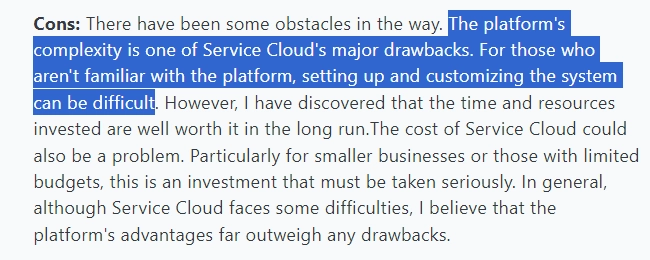
Source: Capterra
- Expensive: Salesforce Service Cloud is expensive, particularly for startups and small businesses.
- Onboarding: Users found it overwhelming to get started with the initial onboarding since the learning curve is steep.
Pricing (per seat/month)
- Starter: $25
- Professional: $80
- Enterprise: $165
- Unlimited: $3307
- A 30-day free trial is available.
Intercom
Intercom is a desk software solution that includes AI chatbots, customer support platforms, a knowledge base, and a ticket management system—allowing organizations to manage their customer experience.
Pros
- Automation: The AI automation capability of Intercom creates adaptable engagement workflows, yielding measurable improvements in customer satisfaction, retention, and success.
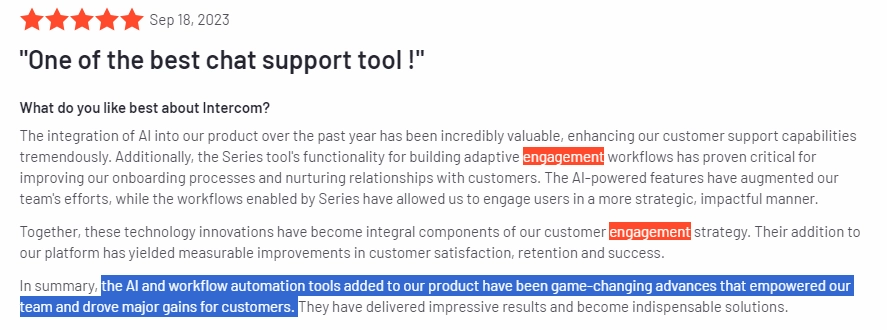
Source: G2
- Add-on features: The option to add-on features and capabilities, such as WhatsApp integration, is considered helpful by users.
- Ease-of-use: Users noted that intercom features over the control panel are simple to configure, allowing them to categorize and distribute tasks, emails, or tickets immediately guaranteeing that there is no delay in the operations.
Cons
- Usability: New product adaptors found the interface, features, and trigger menu options difficult to navigate.

Source: G2
- Customer support: It takes time for the support team to respond rather than immediate feedback, which can create trouble for managers who need to sort out a critical issue.
- Downtimes: Some users have reported that Intercom has significant API downtimes and technical support consistently denies the presence of an issue or downtime.
Pricing (per seat/month, billed annually)
- Essential: $29
- Advanced: $85
- Expert: $132
- A 14-day free trial is available, then costs you $0.99 per resolution.8
For more information about Intercom and its alternatives please check out our data-driven and transparent Intercom Alternatives article.
LiveAgent
LiveAgent provides 180 customizable help desk capabilities (including a built-in contact center ) as well as over 200 third-party integrations. Its ticketing system provides several administration features and buttons. Users can select and sort tickets based on the following:
- status (resolved or pending etc.),
- user & ticket type,
- and importance.
Pros
- The real-time customer support channels are responsive and useful.

Source: G2
- Ease-of-use: Users appreciate the fact that LiveAgent live chat feature is functional and it is a simple-to-use platform that provides a robust and scalable experience for them to resolve customer issues in real-time.
- Email templates: The email templates are useful according to the reviews; users have been able to provide their clients with up-to-date, clear communication through email messaging.
- CSV exports: Users can export their ticketing data in CSV format, allowing for precise data analysis.
- Agent performance management customization: Users can effectively visualize agent performance in a variety of graphical charts by applying filters for agent work time, completed conversations, and answers to created tickets.
Cons
- IOS app: Users have noted that the IOS app lacks functionality and needs an eye-catching user interface.

Source: G2
- Design: Users indicate that the admin interface and user interface could look more modern.
- Ticket filtering: Users cannot see filtering options and tickets on the same screen, making it difficult to choose which filters to use. The interface appears intertwined.
Pricing (per seat/month, billed annually)
- Small: $9
- Medium: $29
- Large: $49
- A 7-day free trial is available.
For more information about LiveAgent and its alternatives please check out our data-driven and transparent article on LiveAgent alternatives.
LiveChat
LiveChat is an online customer support software including online chat, help desk software, and web analytics capabilities. Companies utilize LiveChat as a unified workspace to handle all customer concerns and online communication across several channels (chat, e-mail, and social media sites).
Pros
- Integrations: Users mention that LiveChat has successful integrations with third-party software solutions, transforming it into an outstanding chat-based help desk platform.
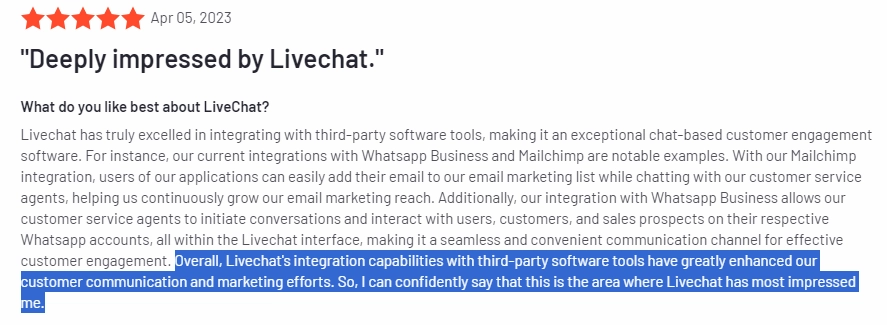
Source: G2
- Ticketing system: Users have a high appreciation for LiveChat’s ticketing system, enabling them to collaborate with various colleagues on a customer service inquiry while remaining within the LiveChat platform.
- Ease-of-use: LiveChat is simple to set up and use, delivering educational and training resources for the employees.
Cons
- Chat console: Chat console may show incorrect data, users have witnessed that when a person leaves the chat, it appears they are still on there.

Source: G2
- Notifications: According to some users, sometimes notifications are missing, making it inefficient to respond to tickets quickly.
- Pricing: The pricing structure is not flexible.
Pricing (seat/month, billed annually)
- Starter: $20
- Team: $41
- Business: $5910
- Enterprise: Contact the vendor
- A 14-day free trial is available.
Front
Front is a customer operations platform that helps companies that are looking to improve productivity in their group email collaboration. It is designed to track response metrics and obtain customer insights to evaluate the team’s and each agent’s performance.
Pros
- Email management: Users compliment the email management features of Front, implying that organizing incoming emails or locating past emails is effortless.

Source: G2
- Customer service: Users indicate that Front’s communication and customer service demonstrate a genuine interest in their product and customers.
- Automation: Users give credit to Front’s automation options, allowing them to easily optimize and streamline our workflows.
Cons
- Learning curve: Front’s learning curve is considered to be high by some users.

Source: Capterra
- Configuration and customization: Some users indicate that the platform has been bloated with configuration and customization choices. Finding the proper configuration and technique for a specific use case might be difficult.
- Pricing: Their pricing strategy could be more customer-friendly.
Pricing (seat/month, billed annually)
- Starter: $15
- Growth: $4
- Scale: $7911
- A 7-day free trial is available.
HubSpot Service Hub
Service Hub is a cloud-based customer service platform that helps organizations of all sizes organize contacts, customer inquiries, and customer service transactions.
Service Hub has a centralized customer relationship management module that enables businesses to organize client information and check the progress of conversations and funnels across all communication platforms in real-time.
Pros
- Knowledge base: The knowledge base is content-rich, and there are numerous clear FAQ-answering video guides available, reducing the amount of time spent communicating with customer service representatives.

Source: Capterra
- Customer support: The support team is easy to contact with just one click.
- Ticketing system: The ticketing function proceeds fluently and accurately in transmitting all the customers’ queries.
Cons
- Functionality: Users have noted that, in comparison to similar technologies, the customer portal is low quality and the interface is completely not customizable.

Source: Capterra
- Meeting tracking: Meeting tracking functions can work more efficiently.
- Customization: Some Hubspot default views or attributes cannot be manipulated.
Pricing (seat/month, billed annually)
- Starter: $18 (includes 2 users)
- Professional: $450 (includes 5 users)
- Enterprise: $1200(includes 10 users)12
- A free trial is available
For more information about HubSpot Service Hub and its alternatives please check out our data-driven and transparent article on HubSpot Alternatives.
Jira Service Management
Jira Service Management is an IT service management software solution based on Atlassian’s Jira platform that connects with Jira Software which enables it to receive, track, manage, and resolve requests from customers.
Pros
- Ease-of-use: Users remarked on how user-friendly Jira’s interface is, allowing them to monitor progress and quickly handle assignments of tasks.

Source: G2
- Centralized management: Jira’s centralized management capability of being able to manage, prioritize, and assign service requests to the appropriate team members has been admired by users, which ensures that requests are addressed in a timely and effective manner.
- Predictive analytics: It enables the prediction of deadlines based on the current status of the work in progress, which is appreciated by users.
Cons
- Learning curve: The learning curve for the end user is not as clear-cut, and it takes extensive preparation from the technical staff in ITIL.

Source: G2
- Performance: Some users may have performance concerns, particularly when working on more complex projects with large amounts of data.
- Cost: JIRA can be costly for small businesses and teams because it requires licensing for users only to view the JIRA board and tickets.
Pricing (seat/month, billed annually)
- Standard: $21
- Premium: $4713
- Enterprise: Contact the vendor
- A 30-day free trial is available.
Key features of help desk software
1- Ticket management
The ticket management system helps respond to client requests in a timely way, hence improving customer experience. A ticketing system can be used to:
- Personalize conversations at scale
- Automate ticket distribution
- Collect customer feedback
- Collaborate with your internal team
2- Ticket automation
By automating the ticketing process, 22% of service desk tickets may be addressed at almost no cost, optimizing workload burden and increasing productivity. 14
Help desk ticket automation features guarantee that support employees can manage a high volume of client requests while maintaining quality and timeliness of response.
3- Call Center
Call center is a built-in telephone integration that provides phone support to your clients directly from your help desk tool.
4- Real-time notifications
85% of help desk software reviewers identify real-time notifications as a highly important feature.15 Real-time notifications notify support team members immediately about ticket updates.
5- Service-Level Agreement (SLA)
A Service-Level Agreement (SLA) is a contract between the customer and service provider. It specifies the degree of service that may be expected from a vendor, such as service type or service delivery date. Including SLAs in your help desk workflow ensures that your employees meet service objectives.
6- Auto-tagging
Auto-tagging scans the text in a ticket description when a ticket arrives at your support desk. It searches for words and matches them to tags previously used in your account.
For those interested in customer feedback automation, here is our in-depth guide.
7- Live chat and widgets
90% of customers consider “immediate” response to be a crucial aspect when seeking customer service and 60% of of them interpret “immediate” as within 10 minutes or less.16 Live chat and widgets a small pop-up window on your website where a visitor may launch a chat session with a representative.
8- Self-service knowledge base
Users can use the self-service knowledge base to complete payments, review customer support tickets, and ask basic queries, without the need for human contact.
9- Customer feedback
A customer feedback feature assists business teams in creating, distributing, and gathering real-time customer data by leveraging sentiment analytics, omnichannel feedback, and feedback automation. A customer feedback feature would allow you to use survey analytics:
- Net Promoter Score (NPS)
- Customer Satisfaction (CSAT) Survey
- Survey Customer Effort Score (CES) Survey
For further reading please check Customer Feedback Analysis Guide.
10- IT help desk
IT help desk allows businesses to give technical assistance to their agents and customers. Employees and IT team members can use a help desk for:
- Troubleshooting issues
- Keeping track of and managing technical tickets
- Incident and asset management
11- Software & app integrations
Integrating applications and tools into your help desk allows you to develop a bespoke platform or expand existing capabilities.
12- Multi-Language Support
Multilingual customer care alternatives will enable you to reach a broader range of customers and connect with your existing end-users in their native language.
A multi-language approach will provide:
- Improved communication quality
- Faster ticket resolution
- Increased consumer loyalty
Feature desriptions
- SOC proves that an organization has implemented essential data security controls:
- SOC 1 focuses on financial reporting,
- SOC 2 focuses on data management practices,
- SOC 3 data management report for the general public.
- ISO 27001 provides a framework for how organizations should manage their data and prove they have a working information security management system (ISMS).
- The Health Insurance Portability and Accountability Act (HIPAA) is a US federal law that governs the privacy of Personal Health Information (PHI) in the US.
Methodology
AIMultiple team completed these steps during the benchmark for each solution:
- Software installation: Installed admin modules.
- Ticket and report creation: Created several tickets and reports to benchmark system effectiveness.
- Primary research: Conducted in-depth product analysis to gather data inputs to create insights based on products’ administration & collaboration capabilities.
Vendor selection criteria
- Number of B2B reviews: 1,000+ reviews
- Average rating: Above 4.0/5
- Employee size: 15+ employees on Linkedin
FAQ
1- What is a help desk?
A help desk serves as the initial point of contact for both customers and customer service agents. Helpdesks include tools that offer insights into client interactions. They also include capabilities that allow you to measure your support team’s performance to verify that your team is efficient in supporting and pleasing customers.
2- What is the difference between a helpdesk and a service desk?
While many businesses use the phrases interchangeably, service desks perform a broader range of IT-related operations than help desks and offer a full complete solution. Help desks are for when “a situation suddenly causes significant trouble”—they are there to fix issues.
Help desks: They are typically utilized for tactical objectives, such as addressing urgent technical difficulties and crises. The ultimate purpose of the help desk is to respond to user inquiries as quickly as feasible.
Service desks: In comparison to help desks, service desks have broader responsibilities and serve as a single point of contact between a service provider and its customers. A service desk considers broad customer service requirements rather than incident resolution. Service desks handle issues, service requests, and user communications.
3- What are the different types of help desks?
Cloud-hosted: Cloud-based help desks, like web-based systems, run and record information on distant servers.
They are, however, more efficient to scale up and down dependent on client demand since they are stored in the cloud.
On-premise: On-premise help desk solutions require a license and are installed locally on your company’s IT system. Companies that use on-premise solutions own their support desk and they are responsible for its maintenance.
Web-hosted: Web-based software is hosted on the servers of the provider. It is accessible through the vendor’s website, and Android or iOS applications.
Open source: Open source solutions provide businesses with access to the software’s source code. This enables businesses to configure the help desk software according to their exact requirements. It is a suitable choice for businesses with highly trained IT staff with technical knowledge.
4- What is a help desk ticket?
A helpdesk ticket is an electronic request that is used to manage and record customer assistance inquiries. These inquiries are created when a customer requires help from a staff member or technical agent to resolve a problem, or query about a product or service.
5- Why do people use a help desk?
Helpdesk solutions consolidate all interactions into a single interface, allowing diverse discussions to provide value to the customer experience.
Some of the fundamental tasks of a help desk are as follows:
– Customer queries are organized as service requests on a unified portal.
– Classifying the flow of tickets.
– Directing tickets to agents.
– Keeping track of a request’s status and pending ticket durations.
6- Why are help desks important?
Help desk software solutions are critical in giving help to consumers and addressing problems with a product or service. A help desk supports employees with a centralized view of all client contacts and serves as a vital resource for knowledge and troubleshooting.
Help desk systems are crucial because they provide:
Enhanced customer satisfaction: A productive help desk may assist in promoting customer happiness by responding to client inquiries and concerns in a timely and effective manner.
Increased efficiency: Help desks may expedite the problem-solving process, which leads to shorter resolution times in answering client requests.
Increased brand value: A help desk can help strengthen your business’s image, by establishing high-quality service standards.
Cost savings: A help desk decreases costs by automating routine operations and sending complex issues to the proper division or team member.
Further reading
If you are interested in help desk technologies, here are other tools and vendors you can check:
- Top 4 Zoho Desk Alternatives for Customer Service
- Top 5 Helpshift Alternatives for Customer Service
- Top 4 Zendesk CRM Alternatives
- Top 4 Freshdesk Alternatives for Customer Service
Don’t forget to check our data-driven, transparent list of help desk software vendors
Transparency statement
AIMultiple conducts financial agreements with numerous technology vendors such as Zendesk Support Suite and Salesforce Service Cloud.
External links
- 1. James, Allen; Frederick F., Reichheld; Barney, Hamilton; Rob, Markey “Closing the delivery gap”. (PDF), Bain & Company. Retrieved July 2, 2024.
- 2. Capterra: Find The Right Software and Services. Capterra
- 3. Bewertungen von Geschäftssoftware und -diensten | G2. G2
- 4. ”Freshdesk Pricing“. Freshdesk. October 7, 2023.
- 5. ”Zendesk Pricing“. Zendesk. Retrieved October 7, 2023.
- 6. ”Zoho Desk Pricing“. Zoho Desk. Retrieved October 7, 2023.
- 7. ”Salesforce Editions & Pricing – Service Cloud Lightning “. Salesforce. Retrieved Oct 7, 2023.
- 8. ”Intercom Pricing “. Intercom. Retrieved January 4, 2024.
- 9. ”LiveAgent Pricing “. LiveAgent. Retrieved October 7, 2023.
- 10. ”LiveChat Pricing “. LiveChat. Retrieved October 7, 2023.
- 11. Freshdesk Pricing & Plans | Freshworks.
- 12. ”HubSpot Service Hub Pricing“. HubSpot Service Hub. Retrieved October 7, 2023.
- 13. ”Jira Service Management Pricing“. Atlassian. Retrieved October 7, 2023.
- 14. ”Service Desk Automation: Are You Missing Opportunities?“. BMC. Retrieved October 9, 2023.
- 15. ”Capterra User Ratings Data – 2023“. Capterra. January 20, 2023. Retrieved October 9, 2023.
- 16. ”HubSpot Annual State of Service Report – 2022“. (PDF). HubSpot. Retrieved October 9, 2023.


Comments
Your email address will not be published. All fields are required.